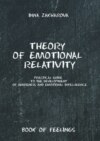Читать книгу: «Theory of emotional relativity. Practical guide to the development of awareness and emotional intelligence», страница 4
Three Types of Joy
1. Calmness
When we meet the values that relate to the need for security (support, knowledge, financial resources), we feel joy, it seems to confirm: “You do everything right, go ahead, do it again.” If it comes to security, then joy will be in the form of calm, lightness, relaxation. When you are in your fortress, there are people around who will support you, you know and possess information, there is enough money in your account – you are calm.
Security + value = calmness
2. Pleasure
When we meet with values relating to the need for love (intimacy, communication, compliments, attractive appearance), we will also feel joy, but in this case it will be in the form of pleasure, enjoyment. When you look at a picture that you like, you feel pleasure, when you communicate with a person who you like, you feel enjoyment.
Acceptance, attention + value = pleasure
3. Satisfaction
When meeting with values that relate to the need for respect (strength, justice, integrity, honesty, responsibility), we feel joy in the form of satisfaction. When you see your cool results that required commitment, you feel deep satisfaction from the work done.
Respect +value = satisfaction
Let’s look at the table and find out what a person with the leading need for security wants to be eager for and what he wants to get rid of.
Security


According to the list in the table, you can notice a values conflict, for example, stability and diversity, or care and freedom. Any diversity implies changes, except in situations when you, having diversity, choose the same. Care, however, implies a connection, and therefore, dependence on another person, and in this case, there can be no talk of complete freedom. There are special relationships with value rules. They are very necessary in order to understand how others should and will act, but I don’t want to act according to the rules myself, as this means a lack of choice and diversity, which are also values. When there are no rules, it’s also bad – chaos (anti-value) arises, you don’t know from whom and what to expect. It turns out that such people need rules and clear instructions, but they themselves violate them.
It turns out that a person with a leading need for security is often very controversial and indecisive, constantly doubting.
The list of values of a person with a leading need for love, acceptance, attention is given in the table below. There are practically no contradictions inside this table. With the exception of sincerity and image, often the image involves a certain embellished look. It turns out that a person with a leading need for love highly values sincerity, but does not want to show himself real.
Love

The third basic psychological need is respect. The values of a person with a leading need for respect are practically the opposite of the values of the need for love.
Respect

There are also practically no conflicts in this list, with the exception of a couple of justice and injustice. As justice is always subjective and is determined basically by systemic rules, it happens that, in an effort to restore justice, people with a leading need for respect are often not fair according to other people.
Let’s remember that all three needs are important for each of us, and look at all three tables with values. You may notice multiple conflicts. For example, autonomy satisfies the need for respect, but denies communication, which is very valuable for satisfying the need for love. And the availability of options, which is so important for satisfying the need for security, means evasion and unwillingness to make decisions that do not satisfy the need for respect. Only a good understanding of yourself, clear internal priorities and conscious goals allow you to resolve these internal conflicts and find the necessary balance among your needs. There are possible value conflicts in the table below. Columns indicate needs, and rows indicate conflicts.



It turns out that we are all constantly in a state of internal conflict. To resolve this conflict, we need emotional competence. Only emotions can show us the truth about ourselves if we learn to hear and understand them.
How to Define your Values?
Anything can be valuable to you if you have an emotional response to this (phenomenon, object, creature). If you have “skipped a beat” inside, then you have some relation to this phenomenon, action or event. You somehow distinguished it from others. So a connection has developed between you and something, “this” concerns you more than anything else.
For example, you come to some event and the first thing that impresses the most you is the beauty around: “God, how beautiful it is here”. We conclude that you are touched by the appearance of things, style, you pay attention to beauty, which means that it is in your system of values. And most likely, if you ask yourself the question “What do I feel?”, the answer will be “I feel pleasure, I am so pleased, comfortable, I feel good here.” Accordingly – what is your need being satisfied now? For love, because everything is so beautiful.
And if at the same event you say: “God, how comfortable it is, how fresh, what are comfortable sofas” – this is more about comfort, about security. However there may be variations. If you are sitting on a comfortable sofa and cannot relax, then most likely there are some other factors, values and anti-values that affect your condition. But if a comfortable sofa is enough for you to relax and do what you want, most likely this indicates that you have a body psycho type and it connects to the need for respect.
Ways of defining values:
1. In order to understand your values and anti-values, you just need to observe yourself in everyday life, note what you are emotionally reacting to, what response you have to different situations.
What am I paying attention to?
What do I like?
What is unpleasant for me?
What don’t I want?
If something feels unpleasant, you don’t want it that means you have met with an anti-value, and something opposite to it will be a value.
The criteria that we rely on when choosing purchases also tell us a lot about our values. A person with a leading need for security will choose a mobile phone out of the criteria: the model should be modern, but not too modern; it must be expensive, but at a discount; it must have a certain status, but not stand out much (so as nobody will ask questions for what money it was bought, what taxes you pay, etc.). At the same time, it is important to be at a higher level when you put the phone on the table and feel support among people from whom you want to receive support. Pay attention to the conflicting values. Many functions, features, bells and whistles, time saving, additional features, bonuses – it’s all about security.
The phone that a person with a leading need for love chooses should be, first of all, special, nice, pleasant to touch, he must express his owner, be like him. “God, he’s lilac! I like it.” Model, cost, modern functions, status are nothing in comparison to the pleasure of the aesthetic part of the subject. The prestigious, expensive model that is bought here and now is about a person with a leading need for respect. “I can afford it! I am a champion.”
2. In order to help ourselves determine the values, we suggest looking at all 3 tables, looking through them (they are very different in character from each other) and feeling the qualitative difference to the values that are listed there. Then answer yourself honestly:
Which of these tables is more about me?
We regularly note at the trainings that one of the tables is for each person, people immediately determine which values are more relevant for them as a whole in life.
• Next, it is important to establish a hierarchy of needs. It is necessary to note which table is in the first place for you, which is in the second, which is in the third. For example, in the first place is a table with the need for security, in the second – the need for love, in the third – respect. This means that you don’t pay much attention to values that are in third place.
• In order to study your values much deeper, it is necessary to work with each table separately. Write down those values that are important to you on a piece of paper from each table. This stage is important because one and the same need for security can be met through different values – someone satisfies the need for security with the help of information, someone through a large number of connections with other people in order to receive support.
• Then you need to build a hierarchy among your values. There is a special exercise that demands time and sincerity, it will likely seem unpleasant. The exercise aims at double-checking your value system. You need to remove one value from your list, each time answering the question: “And if you had to give up one thing, what would it be the first?”
When you crossed out one value, the next stage – “What would you give up now?” And so on until the end of the list.
This exercise is usually painful, because we gradually refuse the lower value for the sake of a greater value, and in the end, priorities will be set in their real way. After completing this exercise, a surprise will wait for us. After having lived through each value and sensation, you have to give up it; you look at your value system with tenderness, with a sense of inner agreement. The value which you gave up first will be at the end of the list. The value which you have not completely given up will be at the top of the values. Since we will have values from all three needs on this list, it will be obvious what your need is really leading. For example, it may turn out that all the values from the need for security will be at the bottom of the list, and at the top there will be values of the need for love, or vice versa. In this way you can look honestly at yourself. Perhaps, you worry about things that are actually not so important to you most of the time in your life. This is worth realizing while doing this exercise.
What is important to remember:
1. Values are something that satisfies our current needs.
2. Anti-values create even greater urgency of need.
3. Each need has special values that may conflict, or contradict each other.
4. Knowledge of our values and their hierarchy can resolve internal conflicts, set true goals.
5. The saturation of life with true values leads to a feeling of happiness.
6. Happiness is a real satisfaction with oneself and one’s life.
Emotions
Emotions are a mental process grabbing the whole person, which change his thoughts, biochemistry, sensations and behavior. As have already been mentioned, the purpose of emotions is to establish the significance of certain conditions to meet actual needs. Based on emotions, we unconsciously conclude whether there is anything valuable in the upcoming event or phenomenon and make a decision how to act.
For example, you are invited to a birthday, immediately there is an emotion of either desire or resistance. It most likely depends on how much communication with this person satisfies your needs. If the communication with him satisfies your needs, you will agree, if not, you will find a reason to refuse. But it happens that the person who invites you is unpleasant in communicating, but you think that he can affect your life, and communicating with him will bring satisfaction to needs in the future. Then you will feel several emotions at once, which will unite into a single feeling.
Feelings are emotions of a higher order. Their goal is to single out phenomena that have stable motivating significance.
Let’s compare feelings and emotions, what are their differences.
Emotions and feelings arose in the process of evolution, but feelings are associated with the ability to think, reason and draw conclusions, and only the modern part of the brain – the neocortex is capable of this. Emotions are born in the more ancient part of our brain – in the limbic system.
Emotions show us what is important for us now, while feelings indicate a direction towards unchanging values.
Emotions are fleeting, they can change dozens of times per minute, if it is eventful. Feelings are very stable, they are based on deep convictions and they are not so easy to shake and change.

There is a simple example: a person can sit in a comfortable apartment with a loved one, experience emotions of joy and tenderness, but feel fear in the background, as changes are coming at work, and this situation according to the personal experience and beliefs, does not lead to anything good.
A feeling can contain one and many emotions at the same time and can express any of them. For example, a person may experience a surge of tenderness when he sees a small kitten – it will be an emotion. And if he always feels tenderness at the sight of any kitten, as he had a cat in childhood and convinces that there is nothing nicer in the world, so this is a feeling. This is an example where a feeling contains one emotion, and that’s why the external expression of a feeling and an emotion will coincide.
It is more difficult when the feeling is multi-component and contains several emotions. For example, guilt contains 4 emotions: fear, anger, sadness, desire. A person experiencing this feeling can express it through any of these emotions. For example, his emotional habit may be an expression of the emotion of anger when he feels guilty. Feeling guilty is very uncomfortable for living, a person experiences unpleasant sensations, so he often wants to run away from them, in this example, to anger. It will seem that such a person does not feel guilty, that he is angry, but this is not true. Another emotional habit is to express guilt through sadness, then a person seeks to retire, dive in himself, cry and do nothing. Sometimes it seems that the mood is changeable, as the expressed emotions can replace each other in a chaotic manner. So a guilty person can first swear loudly, then shut himself up and even cry, the next moment run away, afraid of punishment, then swear and scream again, and at some point become too helpful to compensate for the damage.
In general, feelings of guilt and resentment deserve special attention and a separate chapter, as they monitor the implementation of the system law, which we will consider later.
Let’s first understand what emotions tell us. Everything is actually very simple if you read and use the information that emotions convey to us from the present moment, right here and now. If you do not understand your emotions and ignore them, then they are woven into tangles of emotional tension and turn into multi-component feelings that are difficult to understand without special knowledge and training.
At first, there are many psychological models that offer different emotions as basic ones. We suggest taking emotions that differ in internal sensations. Our task is to learn to distinguish them within ourselves, and then to learn how to express them in such a way as to live them in the present moment and not to pull a long emotional train through our lives. Darwin also identified 7 basic emotions: fear, anger, sadness, disgust, shame, surprise. After a while, S.S. Tomkins added interest to this list, and A. Lowen added tenderness as an experience of agreement and acceptance.
1. Joy
2. Desire
3. Tenderness
4. Surprise
5. Sadness
6. Anger
7. Disgust
8. Shame
9. Fear
These are 9 emotions that are very different in their internal sensations according to various criteria, 8 of which carry information about the current state of person’s psychological needs, define the direction for actions and release energy for them. Five of them we call the emotions of scarcity (when we are missing something) – these are fear, anger, shame, disgust, sadness; and tenderness, joy, desire are emotions of fulfillment (when we get what we need). There is an important emotion to remember —surprise. We did not include it in the composition of neither emotions of fulfillment, nor scarcity, since it does not carry information about the state of psychological needs, but it is important for our development and is transitional between them. Surprise tells us that we met with something that we did not expect and it is part of such feelings and conditions as insight, awareness, consciousness, etc.
Any feeling consists of these 9 emotions. It is like a palette of paints of primary colors, combining which in different proportions, you can get an unlimited variety of shades.
As colors have saturation, and emotions have intensity. People do not often have enough words to name their emotions, there are some ways to name these emotions in different intensities:
Fear
Fear, numbness, nightmare, panic, horror, dread, perplexity, confusion, misgiving, excitement, frustration, anxiety, worry, fear, commotion, doubt, fright, surprise, uncertainty, indecision, funk.
Anger
Anger, wrath, rage, fury, indignation, resistance, resentment, bitterness, rampage, irritation, aggression, discontent, protest.
Shame
Shame, awkwardness, shyness, embarrassment, inferiority, disgrace, absurdity, worthlessness.
Disgust
Disgust, rejection, hostility, antipathy, nausea, loathing, aversion, abomination.
Sadness
Sadness, loneliness, hopelessness, boredom, indifference, laziness, pain, melancholy, bitterness, doom, grief, meaninglessness, unhappiness, longing, apathy, frustration, despondency, emptiness, frustration.
Desire
Desire, urge, interest, motivation, curiosity, aspiration, inspiration, impatience, attraction, thirst.
Joy
Joy, happiness, pleasure, peace, satisfaction, fun, delight, calm, euphoria, ecstasy, relief, bliss, enjoyment, lightness.
Tenderness
Tenderness, deification, intimacy, affability, love, sympathy, acceptance, admiration, communion, worship, heartiness, adoration, goodwill, kindness, warmth, gentleness, affection.
Surprise
Surprise
Any emotion is information about the degree
of satisfaction of psychological needs and energy
for actions that can satisfy these needs.
Besides the fact that you need to be able to notice and recognize an emotion, you must be able to use the energy that appeared in the body due to biochemical processes, in other words – to process an emotion. Otherwise, this unused energy will destroy us from within. So unplanned emotions first lead to tension in the muscles, which accumulating, passes into clamps and blocks, disrupts the proper blood flow and eventually transforms into physical body diseases.
Unfortunately, most people do not have a focus on emotions, people know one thing for sure – there are negative emotions that you don’t want to experience, but there are pleasant emotions, but they need to be earned and not to be shown to anyone, as they are not decent and too personal.
Actually real emotions are sincere; this is information that exposes us to real ones. Not many people in the modern world are ready to take off their masks and face themselves true, and to show others – just beyond the line. But there is no other way to happiness, if you do not want to be happy, do not read on this book.
Life Cycle of Emotions:
• Sensation
• Awareness
• Mobilization
• Action
• Final contact
• Satisfaction
• Withdrawal
Life cycle of emotions is described in Gestalt approach.
At first, an emotion is born somewhere deep in the subconscious, we still do not know, but it already exists. Then it rises to the level of our inner sensations, at some point it is not yet visible from the outside, but already at the level of sensations it let itself know. The next stage of the life cycle of emotions (mobilization) begins when the emotion expression covers the whole body, when each of its cells responds to the call. At this moment we are processing an emotion, we allow it to express out-of-body. This is very important, it is healing the body. Emotions that we do not process hide inside our body. As our emotions are not only information, but also a large amount of energy, which has its own characteristic and direction, this energy gets stuck inside our body and begins to destroy it. The next stage in the life cycle of an emotion is action. What does it mean to understand an emotion? Firstly, it should be noted what it is and give it a name. Only then we can say that we have realized the emotion. The process of action does not end there, it is very important to decipher the information that the emotion carries.
Why has it appeared now?
What does it mean?
What important things are happening with me now?
The energy that is contained in any emotion is designed to meet our current psychological needs, so it is very important to ask yourself important questions and direct your activities to an acceptable and ecological way to get what you want.
And then the next stage begins – the satisfaction stage, in which we transform the energy of emotion into our real actions. Thus, the transition to the final stage – the withdrawal of an emotion is smoothly carried out. We can say that an emotion leaves our body, giving an empty space for other emotions.
Here is such a natural life cycle – birth (sensation), adulthood (awareness), mobilization, action, transformation (final contact), satisfaction, withdrawal. This cycle is suitable not only for emotions, but also for any life processes. It is important to understand how necessary it is to process emotions, otherwise severe conditions and illnesses will not keep you waiting.
For various reasons, people express emotions differently. In order to allow emotions to be shown, you need some inner courage, an inner willingness to see your needs and stop considering them as weaknesses. The ability to admit sincerely your needs is the position of a strong person.
But instead, we often protect against our emotions, hide them under different masks guiding by various limiting beliefs.











